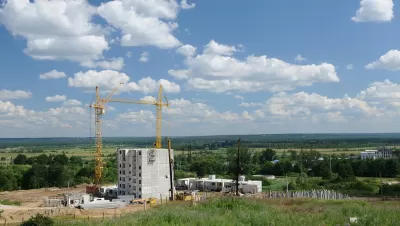A new paper by the People's Policy Project explains why and how a government-owned municipal housing development, i.e., social housing, can address the nation's housing affordability crisis.

Peter Gowan and Ryan Cooper pitch a program of government-owned municipal housing development, which they argue would address the need to increase the number of affordable dwellings in high cost cities in the United States. "Unlike traditional American public housing, all city residents will be eligible to live there," according to Gowan and Cooper.
The article's case for what it calls social housing begins by touting its ability to release price pressure and deliver units at scale to meet the needs of more than just the very top of the market. This isn't the "filtering" argument of market urbanists, however—"not only is that an unreliable procedure (many very old buildings remain expensive), it will take decades to happen."
The second line of argument is that "by allowing people of all incomes to apply to live in these new developments, local governments will be able to charge higher rents to higher-income residents, and thus capture a great deal of capital income."
According to Gowan and Cooper, such a housing policy would only be innovative in the United States. Sweden, Finland, and Austria are referenced. Sweden is also cited as the benchmark for a goal by the United States: "We suggest that 10 million new municipal housing units would be a viable 10-year goal. That is well short of a scaled-up version of the Swedish program, but still quite aggressive. We do not anticipate a U.S. affordable housing oversupply being a significant risk in the medium term."
The article concludes with more details about how a municipal housing program could work in the United States.
The study by Gowan and Cooper has been picked up by multiple media outlets, like The Guardian and Jacobin.
FULL STORY: A Plan to Solve the Housing Crisis Through Social Housing

Alabama: Trump Terminates Settlements for Black Communities Harmed By Raw Sewage
Trump deemed the landmark civil rights agreement “illegal DEI and environmental justice policy.”

Study: Maui’s Plan to Convert Vacation Rentals to Long-Term Housing Could Cause Nearly $1 Billion Economic Loss
The plan would reduce visitor accommodation by 25% resulting in 1,900 jobs lost.

Why Should We Subsidize Public Transportation?
Many public transit agencies face financial stress due to rising costs, declining fare revenue, and declining subsidies. Transit advocates must provide a strong business case for increasing public transit funding.

Paris Bike Boom Leads to Steep Drop in Air Pollution
The French city’s air quality has improved dramatically in the past 20 years, coinciding with a growth in cycling.

Why Housing Costs More to Build in California Than in Texas
Hard costs like labor and materials combined with ‘soft’ costs such as permitting make building in the San Francisco Bay Area almost three times as costly as in Texas cities.

San Diego County Sees a Rise in Urban Coyotes
San Diego County experiences a rise in urban coyotes, as sightings become prevalent throughout its urban neighbourhoods and surrounding areas.
Urban Design for Planners 1: Software Tools
This six-course series explores essential urban design concepts using open source software and equips planners with the tools they need to participate fully in the urban design process.
Planning for Universal Design
Learn the tools for implementing Universal Design in planning regulations.
Smith Gee Studio
Alamo Area Metropolitan Planning Organization
City of Santa Clarita
Institute for Housing and Urban Development Studies (IHS)
City of Grandview
Harvard GSD Executive Education
Toledo-Lucas County Plan Commissions
Salt Lake City
NYU Wagner Graduate School of Public Service





























